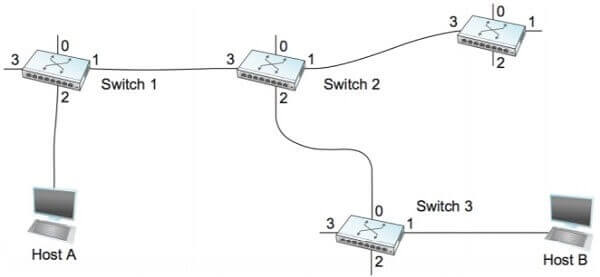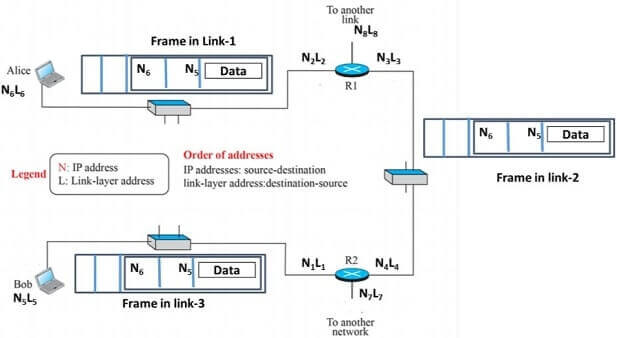SIT202 Computer Networks Problem
Question 1
10 marks
1) What is the (definition of) bit rate? [2 mark]
2) If the number of signal levels is 8, the bandwidth is 3 MHz, and two samples are taken per Hertz, what is the bit rate? [2 marks]
3) Suppose that the signal-to-noise ratio (SNR) is 6 dB. What is the capacity (in bits per second) if the bandwidth is 3 MHz? [2 marks]
4) Discuss the difference between the bit rate and the capacity (e.g., answer why they are different?) [4 marks]
Question 2
10 marks
1) Explain the purposes of multiplexing and demultiplexing (in physical layer)? [4 mark]
2) Place one of “circuit-switching” and “packet-switching” into the followings sentences [3 marks]
- “…” can further be divided into two subcategories – virtual-circuit approach and datagram approach.
- “…” takes places at the physical layer.
- In “…,” the resources need to be reserved during the setup phases.
3) Suppose that a packet is transmitted from Host A to Host B. The VIC of the packet at Host A is “c”. What is VCI when the packet is arrived at Host B. [3 marks]

| Incoming | Outgoing | ||
|---|---|---|---|
| Port | VCI | Port | VCI |
| 0 | a | 0 | d |
| 1 | d | 3 | c |
| 2 | c | 1 | b |
| 3 | b | 2 | e |
| 0 | e | 1 | h |
| 1 | f | 3 | g |
| 2 | g | 2 | e |
| 3 | h | 0 | f |
Question 3
13 marks
1) Consider the parity-check code with 4-bit dataword [4 marks]
- What is the length of the codeword?
- How many codewords the code has?
- What is the minimum Hamming distance?
- How many errors can be corrected?
2) [6+3 marks] In the following network, two hosts Alice and Bob are connected by three links and two routers. There are two addresses (N: IP address and L: Link layer address) for each interface of hosts and routers. Host Alice sends a datagram to host Bob. The datagram passes through the routers and links to host Bob. Before sending, Alice makes a frame from the datagram, then sends to the router-R1.
Explain how host Alice encapsulates the frame from the datagram, and then explain how Router-R1 and Router-R2 prepare and forward those frames on link-2 and link-3 towards host Bob. Mention how Alice gets R1’s link layer address, how routers get next destination and link layer addresses in your explanation. Mention all link layer addresses (source and destination) for all three frames in the links.

Marking:
Explanation of Alice and two routers’ frame preparation and forwarding (6 marks):
6 marks – mostly good explanation/s, explained all steps including how the encapsulation happens for frame, ARP, routing decision of hosts or router whichever applicable in each case.
5 marks – mostly good explanation/s, explained the steps including how the encapsulation happens for frame, however did not mention either ARP or, routing decision.
4 marks- Explained but has incorrect explanation mostly in one case error (in ARP and routing)
3 marks – average explanation/s, with incorrect aspects in two cases, partial correct in ARP or routing.
2 marks-poor explanation/s, with incorrect aspects in two cases and missing ARP and routing explanation.
1 marks – the answer is largely incorrect, with incorrect aspects in three cases, partly correct in one cases;
0 marks – no parts of the answer are correct and/or there has been no attempt to address any of the requirements of the question.
Link layer addresses (3 marks)
3 Marks: the source and destination link layer addresses of three frames are correct (0.5) each
2 Marks: the source and destination link layer addresses of two frames are correct (0.5) each
1 Marks: the source and destination link layer addresses of one frame are correct (0.5) each
0 Marks: You did not attempt or all your diagram is incorrect
Question 4
12 marks
1) Choose “Yes” or “No” for each item? [6 marks]
| Are there packet collisions? | Is carrier sensing required? | Is the number of the stations fixed? | |
|---|---|---|---|
| TDMA | |||
| Polling | |||
| Slotted-ALOHA | |||
| CSMA/CA |
* Each answer has 0.5 marks: For the final mark, the total sum is rounded.
2) Choose all wireless technologies in the followings. [2 marks]
- Bluetooth
- Gigabit ethernet
- 802.11n
- ADSL
- SONET
3) Choose “True” or “False” for each item? [4 marks]
| True or False | |
|---|---|
| In AMPS, CDMA has been used for channelization. | |
| Handoff is used in a cellular system to support continuous transmission for a mobile station. | |
| In CDMA-based cellular systems, the frequency-reuse factor can be 1. | |
| CSMA/CD is used for wireless LAN at it can avoid the hidden node problem. |

